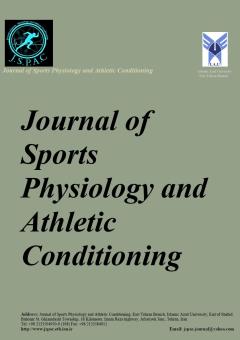The effect of whey supplementation on some indicators of muscle damage in elite soccer players
الموضوعات : تغذیه ورزشی
Fatemeh Baqeri
1
,
Valiollah Shahedi
2
,
Arezoo Kalhor
3
![]() ,
Masoumeh Hashemi
4
,
Mahsa Shirazi
5
,
Faeze Gholami
6
,
Masoumeh Hashemi
4
,
Mahsa Shirazi
5
,
Faeze Gholami
6
1 - Department of Physical Education and Sport Sciences, East Tehran Branch, Islamic Azad University, Tehran, Iran
2 - Department of Physical Education and Sport Sciences, Parand Branch, Islamic Azad University, Tehran, Iran
3 - Department of Exercise Physiology, Karaj Branch, Islamic Azad University, Tehran, Iran.
4 - Department of Physical Education and Sports Sciences, East Tehran Branch, Islamic Azad University, Tehran, Iran
5 - Department of Physical Education and Sports Sciences, East Tehran Branch, Islamic Azad University, Tehran, Iran
6 - Department of Physical Education and Sports Sciences, East Tehran Branch, Islamic Azad University, Tehran, Iran
الکلمات المفتاحية: whey, muscle damage, soccer players,
ملخص المقالة :
Background: Aerobic exercise causes muscle damage and inflammation. The aim of this study was to examine the effect of whey supplementation on some indicators of muscle damage in elite soccer players.
Materials and Methods: A semiexperimental study was conducted on 18 male football players from the national youth football team (16-18 years old) who took part in the training camp and were divided into two experimental and placebo groups. The experimental group consumed 25 grams of whey protein supplement with purity of over 90% daily for four weeks, and the control group received 25 grams of starch placebo (8). All subjects participated in the football competition camp's routine exercises. Correlated and independent t-tests were used to determine intra-group and inter-group differences. The collected data were analyzed at a significance level of p≤0.05.
Results: The results showed that concurrent training and buttermilk consumption has a significant effect on reducing waist circumference, systolic and diastolic blood pressure, low-density protein, triglycerides and a significant increase in high-density protein in overweight girls, p≤0.05.
Conclusion: Young athletes can use the whey supplement to speed up the recovery process to prevent muscle pain and damage after sports activities, especially eccentric activities.
1. Ghoochani, S., Riyahi Malayeri, S., Daneshjo, A. Short-term effect of Citrulline Malate supplement on LDH and Lactate levels and Resistance Exercise Performance. Journal of Military Medicine, 2022; 22(4): 154-162.
2. Shirvani, H., Riyahi malayeri, S., Akbarpour Bani, M., Kazemzadeh, Y. The Effects of Taurine Supplementation with High Intensity Intermittent Exercise on Serum IL-6 and TNF-α in Well-Trained Soccer Players. Journal of Sport Biosciences, 2013; 5(2): 59-79. doi: 10.22059/jsb.2013.35040.
3. Goodarzi, A., Bambaei chi, E., Rahnama, N. The Effect of a Futsal Match on Some Biochemical Markers of Muscle Damage (Cr & AST). Journal of Sport Biosciences, 2015; 7(1): 1-10. doi: 10.22059/jsb.2015.54272
4. Riyahi Malayeri, S., Mirakhorli, M. The Effect of 8 Weeks of Moderate Intensity Interval Training on Omentin Levels and Insulin Resistance Index in Obese Adolescent Girls. Sport Physiology & Management Investigations, 2018; 10(2): 59-68.
5. Vasconcelos QDJS, Bachur TPR, Aragão GF. Whey protein supplementation and its potentially adverse effects on health: a systematic review. Appl Physiol Nutr Metab. 2021 Jan;46(1):27-33. doi: 10.1139/apnm-2020-0370. Epub 2020 Jul 23. PMID: 32702243.
6. Mor, A., and Ipekoglu, G. The Effect of Whey Protein Supplementation on Exercise-Induced Muscle Damage, International Journal of Medical Research & Health Sciences, 2018, 7(7): 132-137.
7. Spoelder M, Koopmans L, Hartman YAW, Bongers CCWG, Schoofs MCA, Eijsvogels TMH, Hopman MTE. Supplementation with Whey Protein, but Not Pea Protein, Reduces Muscle Damage Following Long-Distance Walking in Older Adults. Nutrients. 2023 Jan 10;15(2):342. doi: 10.3390/nu15020342. PMID: 36678213; PMCID: PMC9867418.
8. Samadi, M., Soleimani, D., Moradi, M., Kamari, N., Rezaei, M., Hozoori, M. The Effect of Whey Protein Supplementation on Inflammatory Markers and Muscle Damage in Basketball Athletes: A Double-Blinded Clinical Trial. Journal of Isfahan Medical School, 2021; 39(640): 659-664. doi: 10.22122/jims.v39i640.14166.
9. Rohani H, Asjodi F, Safarimosavi S, Bahmanzadeh M. The Role of Resistance Training and Whey Protein Intake on Delayed Onset Muscle Soreness Indices after Eccentric Resistance Exercise in Untrained Men. Iranian J Nutr Sci Food Technol 2017; 12 (1) :11-20
URL: http://nsft.sbmu.ac.ir/article-1-2210-en.html
10. Huang WC, Chang YC, Chen YM, Hsu YJ, Huang CC, Kan NW, Chen SS. Whey Protein Improves Marathon-Induced Injury and Exercise Performance in Elite Track Runners. Int J Med Sci. 2017 Jun 22;14(7):648-654. doi: 10.7150/ijms.19584. PMID: 28824296; PMCID: PMC5562115.
11. Ha E, Zemel MB. Functional properties of whey, whey components, and essential amino acids: mechanisms underlying health benefits for active people (review). J Nutr Biochem. 2003 May;14(5):251-8. doi: 10.1016/s0955-2863(03)00030-5. PMID: 12832028.
12. 12- Foegeding EA, Davis JP, Doucet D, et al. Advances in modifying and understanding whey protein functionality. Trends in Food Science & Technology. 2002; 13(5):151‒159.
13. 13- Lollo PCB, Amaya-Farfan J, Faria IC, SalgadoJVV, Chacon-Mikahil MPT, Cruz AG, Oliveira CAF, Montagner, PC, Arruda M. Hydrolysed whey protein reduces muscle damage markers in Brazilian elite soccer players compared with whey protein and maltodextrin. A twelve-week in-championship intervention, International Dairy Journal. 2014; 34, 19-24.
14. Mor A, and Ipekoglu G. The Effect of Whey Protein Supplementation on Exercise-Induced Muscle Damage, International Journal of Medical Research & Health Sciences, 2018, 7(7): 132-137.


